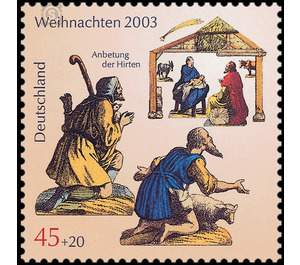Christmas - Germany / Federal Republic of Germany 2003 - 45 Euro Cent
| Country | Germany / Federal Republic of Germany |
| Issue Date | 2003 |
| Face Value | 45.00 |
| Stamp Type | Postage stamp |
| Item Type | Stamp |
| Chronological Issue Number | 2242 |
| Chronological Chapter | GER-BRD |
| SID | 820708 |
| In 24 Wishlists | |
For the special postage stamp series "Christmas" of the year 2003 motives were selected from a printed around 1900 crib cutting sheet, which is in the collection of the Bavarian National Museum. The earliest printed cut-outs at the beginning of the 18th century were executed as engravings. The invention of lithography in 1798 brought about drastic changes. With increased print quality, high runs of thousands of sheets could be achieved. The nativity figures from the excerpts in the second half of the 19th century were an affordable alternative to the carved or modeled figures for broad sections of the population, especially with the introduction of color lithography at the end of the 19th century. The motif of one stamp shows the main characters of Christmas Night, the baby Jesus and his parents Mary and Joseph, in the nursery. Above the roof, the star of Bethlehem glows delicately and narrowly. The two animals, ox and donkey, which although not mentioned in the biblical account of the birth of Jesus, have always been indispensable to the motif since early depictions of the Holy Night, are depicted here in the background of the stable. Josef has taken a seat on a log, in conversation with an unrepresented opposite, while Mary, sitting on a stool with the baby Jesus in her lap, turns to the shepherd. The list of nativity figures provided by the artist can be recognized on the other motif: Here, two adoring shepherds have come to the fore. Her oriental-looking clothing is a typical representation of the 19th century. At that time it was customary to depict the landscape and people of the Holy Land as faithfully as possible. While the artist who drew the lithograph is not known, the publisher in which the picture sheet was printed and distributed can be precisely defined, because the sheet bears the inscription "Druck und Verlag C. Burckhardt's successor, Weissenburg- Alsace". Between 1888 and 1906, under this name, the second successor company of the once-successful picture-book publishing house of Jean Fréderic Wentzel (1807-1869) was renamed. The successors succeeded in the introduction of color lithography emerging in the last quarter of the 19th century not, so that the company lost importance. This Nativity cutting sheet is therefore still stencil-colored, that is, the colors are applied by means of a stencil by hand subsequently to the pressure.


